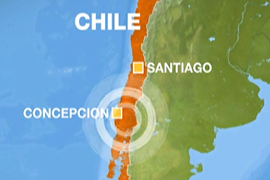Chile quake leaves hundreds dead
President declares “state of catastrophe” after 8.8-magnitude earthquake strikes close to country’s second largest city.

“I want to call on all the people of Chile to remain calm … There have been some aftershocks, but so far our national organisations are still up and running,” she said.
Jason Mitchell, a freelance journalist in Santiago, told Al Jazeera: “A new president takes over Chile in about 12 days time, so this was a transitional time.
“Sebastian Pinera, the incoming president … His ministers have all met with the outgoing ministers and they’re trying to build a co-ordinated response.”
He continued: “Chile’s a country that has earthquakes before, so it was reasonably well prepared for this. The country has some of the most strictest building laws in the world.”
Tsunami warnings
Japan issued a major tsunami alert for its Pacific coastline on Sunday, ordering more than 10,000 people to evacuate vulnerable areas.
|
Al Jazeera is not responsible for the content of external websites |
The Japan Meteorological Agency warned that waves of up to three metres high could hit the northern areas of Aomori, Iwate and Miyagi, even as fears of destructive waves eased across the rest of the Pacific.
A four-metre high wave triggered by the earthquake hit Hiva Oa, part of the Marquesas Islands in French Polynesia, early on Saturday but there were no casualties, the high commissioner said.
Waters receded from Hawaii’s shore at around 11am (2200GMT) on Saturday, with residents braced for high waves, but the tsunami alert was lifted a few hours later, the Pacific Tsunami Warning Centre said.
Waves up to 1.5 metres high also rammed into New Zealand on Sunday, but there were no reports of serious damage.
In Australia, officials recorded the first effects on Sunday of the wide-ranging tsunami, reporting a rise in sea levels, but no major waves.
Kevin McCue, president of the Australian Earthquake Engineering Society, told Al Jazeera: “An earthquake of this size occurs one every ten years. This quake would have ruptured the earth’s surface for about 800km, which is a very long fault line to produce a tsunami.
“I’m surprised it produced such a small tsunami as a result. But everyone is still on alert right across the Pacific.”
Warnings were issued for across the Pacific from Latin America to the Pacific Rim nations of New Zealand, Australia, Japan, the Philippines and Indonesia.
Buildings collapsed
Chilean TV showed images of collapsed homes in Concepcion, a large building completely engulfed in flames and injured people lying in the streets or on stretchers.
 |
It reported that the earthquake had destroyed many roads, making it impossible for vehicles to get through. Electricity and water supplies had been cut.
Phone lines were either down or busy, making confirmation of damage difficult elsewhere, especially further south towards the epicentre.
According to a 2002 census, Concepcion is one of the largest cities in Chile with a population of around 670,000.
In Santiago, Chile’s international airport was to be closed for at least 24 hours due to damage caused by the earthquake, local television reported.
The US Geological Survey (USGS) recorded eight aftershocks, the largest measuring 6.9 magnitude at 08:01 GMT.
In 1960, Chile was hit by the world’s biggest earthquake since records dating back to 1900, USGS data shows.
The 9.5 magnitude quake devastated the south-central city of Valdivia, killing 1,655 people and sending a tsunami which battered Easter Island 3,700km off Chile’s Pacific seaboard and continued as far as Hawaii, Japan and the Philippines.